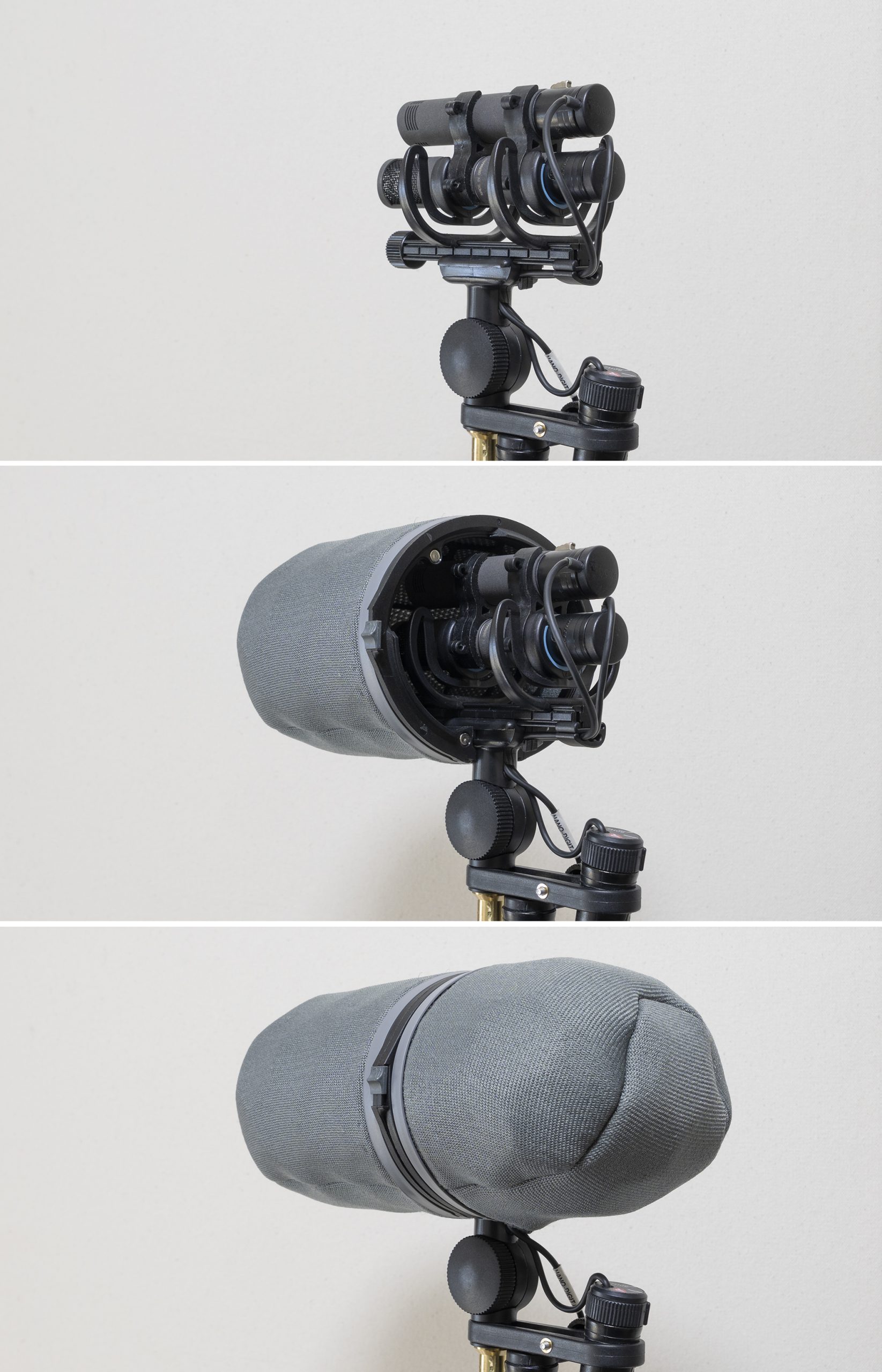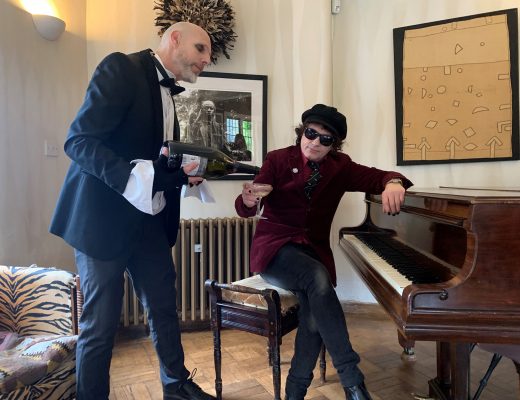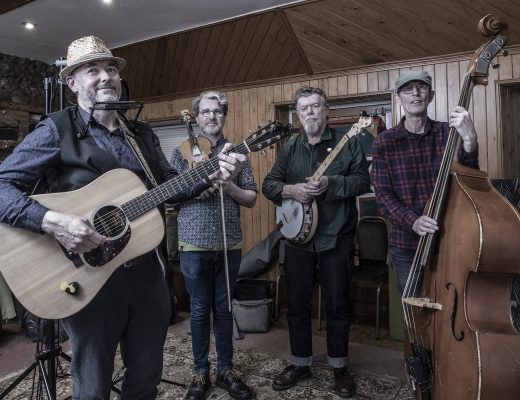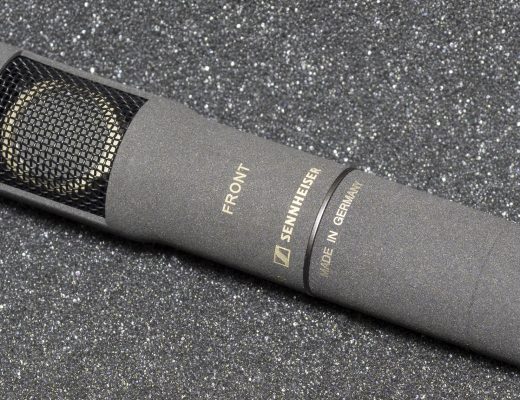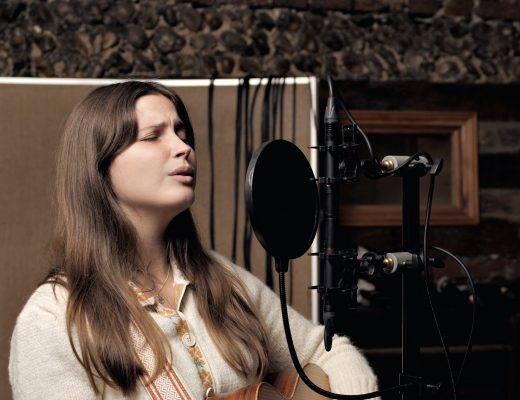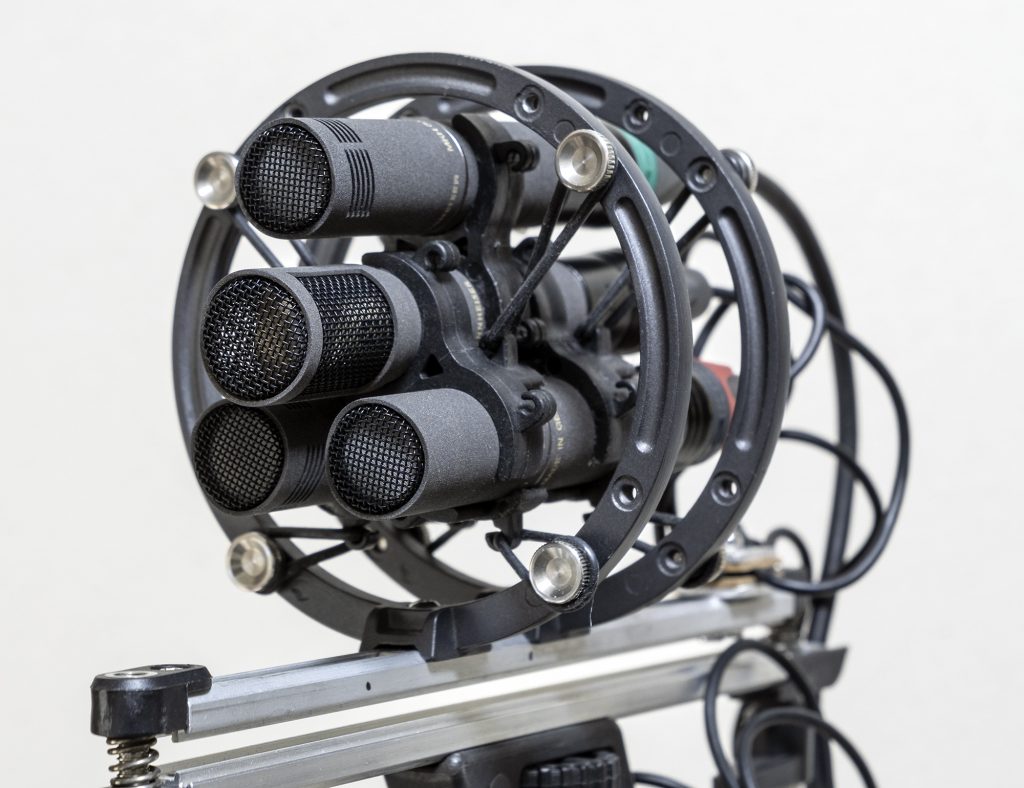
Introduction
Part 2 of the Sennheiser MKH 8030 (fig 8) tests involved recording a bluegrass band with a mid-side set-up, focused on the Sennheiser MKH 8040 (cardioid) and MKH 8030 pair, but including the Rycote BD-10 (fig 8) and CA-08 (cardioid) mics. For the next series of tests I was keen to hear how the MKH 8030 sounded with other mics from the MKH 8000 series in a mid-side pair. There are, of course, five other mics in the series, ranging from omni to long shotgun, but, to make things manageable, I wanted to focus on three mid-mic options: the MKH 8020 (omni), the MKH 8040 (cardioid) and the MKH 8050 (supercardioid). The MKH 8090 (wide cardioid) has much to commend it for a mid mic, but I suspected that the difference between it and the omni and cardioid mics might be a bit nuanced for my tests. Mid-side with shotgun mics is possible, of course, but it’s not something I’m hugely keen on. Besides, I needed a practical rig to be able to test different combinations at the same time, so four mics of similar size was my limit for a blimp. Similar practical matters also ruled out including mid-side with a second MKH 8030 (which would require a different orientation): that, and the fact that I don’t yet have a second MKH 8030! So tests of a fig 8 as the mid mic, and of a Blumlein pair of MKH 8030s, will have to wait until another time.
It has been very clear from the outset that the MKH 8030 is a superb fig 8 mic, condensing much of what is loved about the MKH 30 into a smaller form, so testing its performance in mid-side rigs might seem superfluous: it could be assumed that the mic will deliver excellent mid-side recordings when used with the other MKH 8000 series mics. Well, there are two angles to this: first, it’s good to check that theory and expectations are matched by reality, not least as the MKH 8000 mics are not cheap, and provide samples of this; and, second, I was intrigued by the on-line comment of another tester of the pre-production MKH 8030 mic as part of a mid-side pair, who said ‘the 8050 is too narrow and creates holes in the stereo image and other weirdness when decoding‘. This was for recording nature so narrowness may well have been an issue for desired wide ambiences, but holes and other ‘weirdness’ seemed surprising since the MKH50/MKH30 pair has long been used to good effect. And, of course, a supercardioid or hypercardioid mid-mic choice is an obvious one for production sound recordists (i.e. heavy users of mics with these polar patterns) who want the scope for a bit of mid-side stereo when the occasion arises. (NB as an aside, anyone interested more generally in the stability of hypercardioid – and, by extension, supercardioid – mid mics in mid-side arrays might find Trevor de Clercq’s master’s thesis of interest).
So to these latest tests. Given the comment about the MKH 8050 as a mid-mic, and the previous musical test for the MKH 8030, I have this time focused on field recording – both natural and man-made sounds, and including sounds that cross the stereo field: hopefully, these will allow consideration of any holes in the centre of the stereo image, or other ‘weirdness’. In each of the samples below, the recordings are as straight off the recorder, albeit with levels adjusted in post so that the mid and side mics are mixed at a ratio of 50:50 (I recorded all four channels with the same gain) to reflect the slightly different sensitivities of the mics: i.e. MKH 8020 at -30dBV, MKH 8030 at -30.8dBV, MKH 8040 at -34dBV and MKH 8050 at -34dBV.
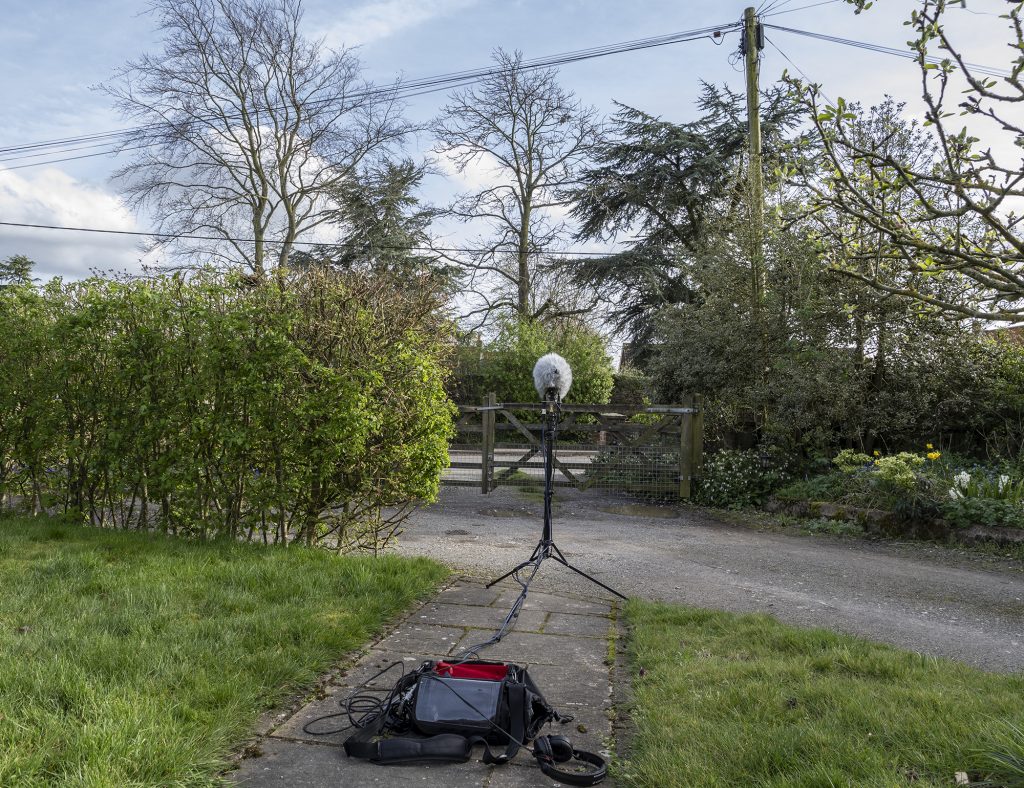
‘The Deserted Village’
First up, is my old and unadventurous stalwart: mics at the front of our garden, at ninety degrees to the street in this quiet Norfolk village, with birdsong and the odd passing car or tractor.
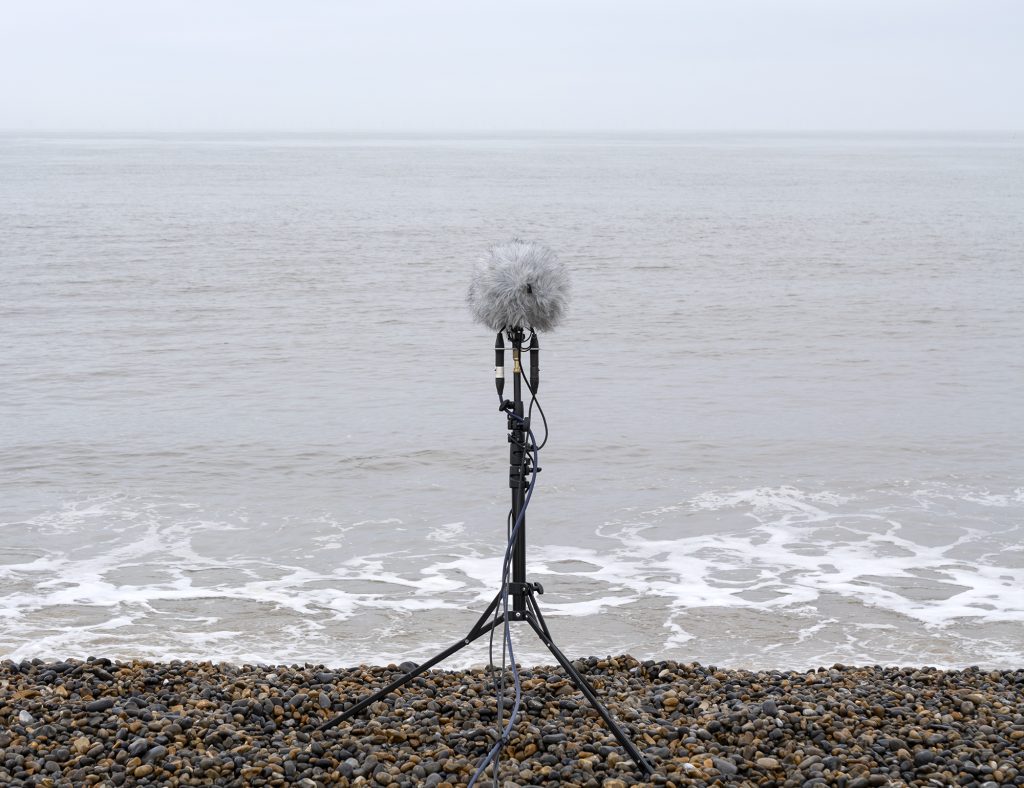
‘Sea-Fever’
Next I took the four-mic MS rig up to the coast. There was a gentle offshore wind, but the shingle beach shelves steeply, so there was some wave action nonetheless. Waves break onto the beach at different times, naturally, so the sound often moves across the stereo image. For this first series of recordings the mic stand was rather near to the sea than in the photo: it was right at the water’s edge – so much so that a couple of times I had to grab the stand and stagger backwards to avoid a clutch of Sennheiser mics taking a dip in the North Sea.
And then, while on the beach, but, say, 30ft (10m) from the water’s edge, I recorded myself walking past the mics, angled downwards a bit, again with the intention of exploring the ‘hole in the middle’.
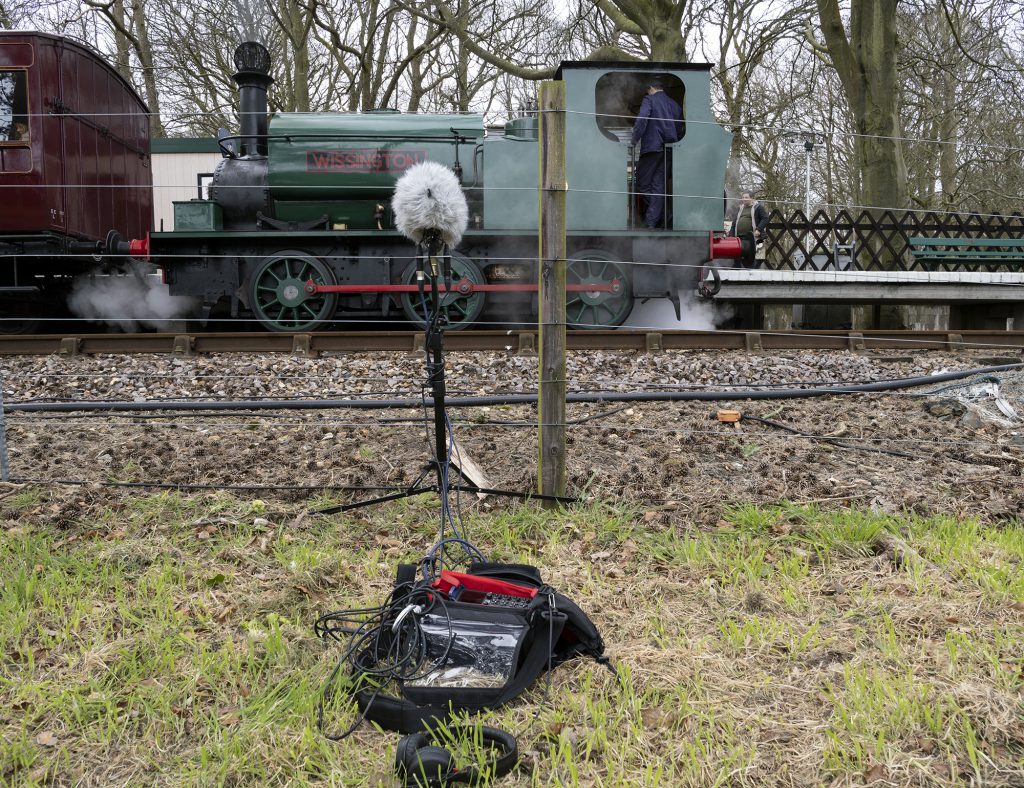
‘At The Railway Station’
A few miles away, the season was was well and truly underway at the North Norfolk Railway, with trains bustling between Holt and Sheringham over the Easter weekend. Setting up lineside opposite a small saddle-tank locomotive, with the station platform beyond, I recorded its departure and the rattle of its carriages as it headed off backwards.
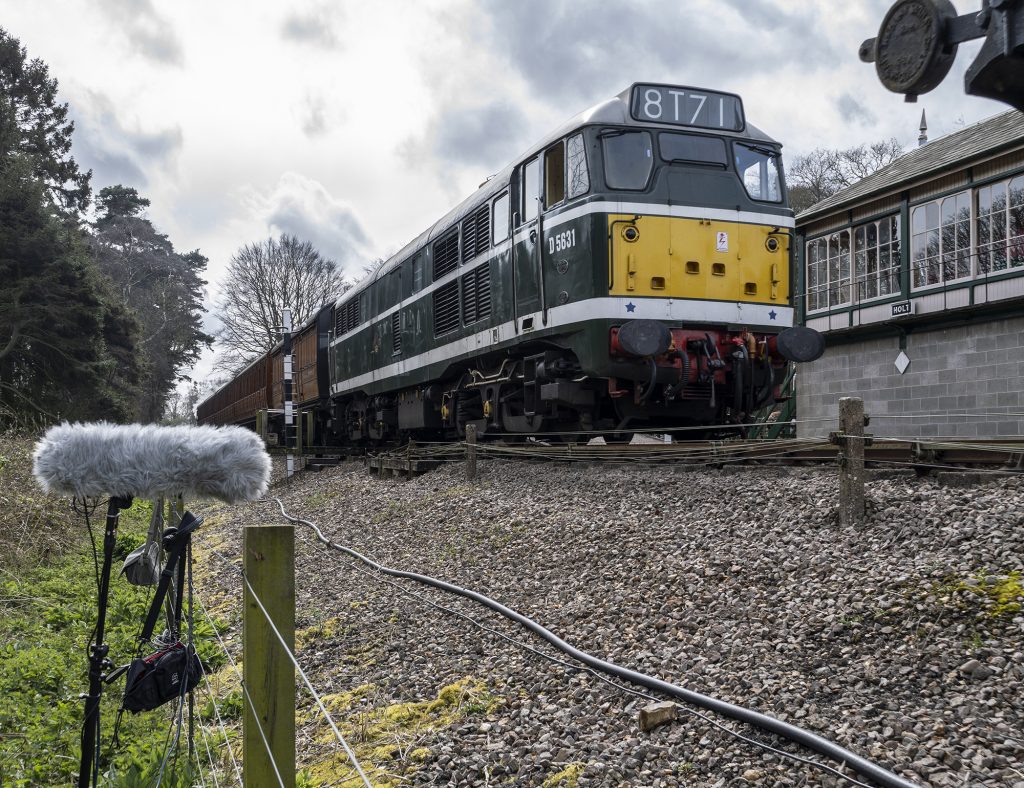
After this small train pulled out, I became very visible to anyone on the platform so perhaps it wasn’t surprising that a chap pointed me out to his toddler grandson, who in response gave a nonplussed shrug way beyond his years. With headphones, a furry blimp and a camera, I must have looked like an über-trainspotter: a fair cop perhaps, but, seeking a less conspicuous position, I moved along the fence by the lineside to a point just beyond the station. There were practical advantages of a less visible location too: chatter from those at the station was reduced, I was further from the car park, and I was next to the signal, with its occasional clunking movements. I settled down to wait for the next train, which then took me unawares as there was no whistle or chuffing to announce its arrival: it was a diesel. Well, it may have lacked the nostalgic charm of steam, but it was a different sound, so I pressed record.
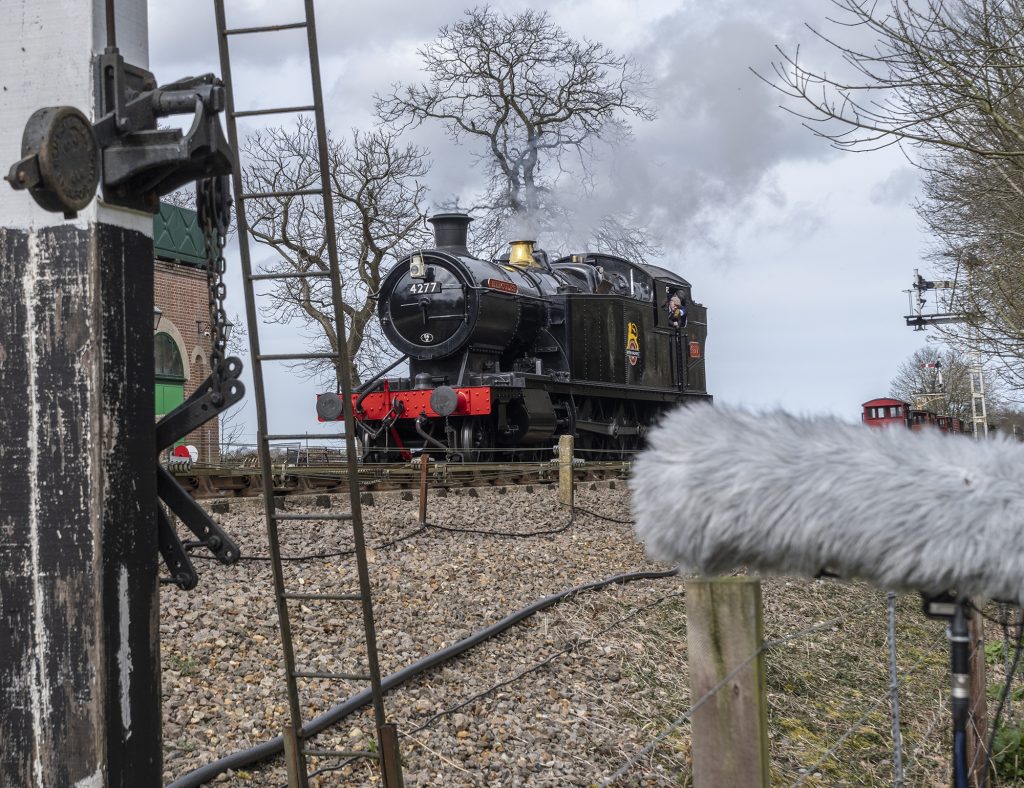
Working on the principle that the locomotive types must be alternating, I waited for the next one to arrive, hoping for another steam engine and perhaps something a bit larger than the little saddle tank. Sure enough, after another 15 minutes or so, along puffed a much larger tank engine, pulling a longer train of carriages. OK, not one of the biggest locomotives on this railway, but noticeably different in sound: a lot bassier, and, as expect, this comes across especially well in the omni mid-side recording. In this case I had the mics angled at forty-five degrees towards the departing train, which, of course, sees the greater emphasis from the omni mid mic on the disappearing sound around 130 off axis..
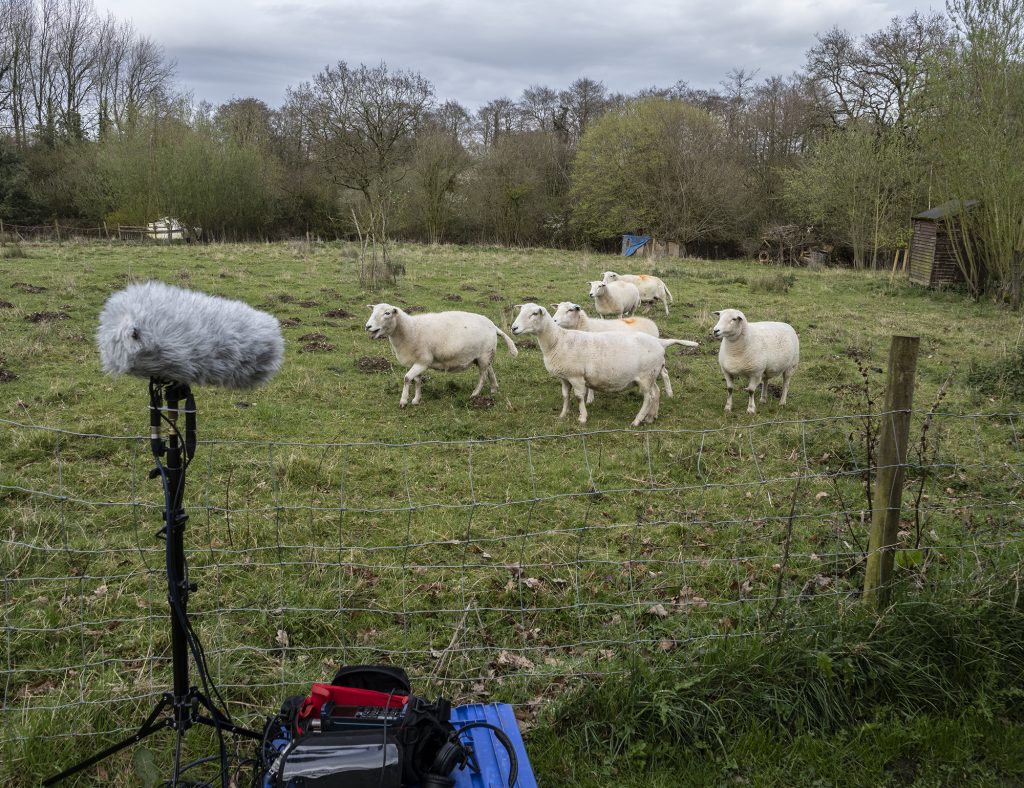
‘The Manor Farm’
Perhaps it was thinking about farming round here when waiting for the little sugar beet ‘Wissington’ loco to set off or perhaps it was thinking about lunch on Easter Day, but for my final set of recordings I popped over to a friend’s house to record his sheep. No lambs yet, but despite the small size of the flock they put in a good performance for the mics: it’s amazing what the appearance of a feed bucket can do. Listening back, I’m surprised at the amount of natural reverb: far from anechoic. In this case the omni mid-mic brings in some less desirable low-frequency background noise and more traffic from the road (a B road, about 120 yards/metres away), but otherwise does a good job: that said, with the principal sound sources in front of the mics, I prefer the MKH 8040 and MKH 8050 mid-mic recordings.
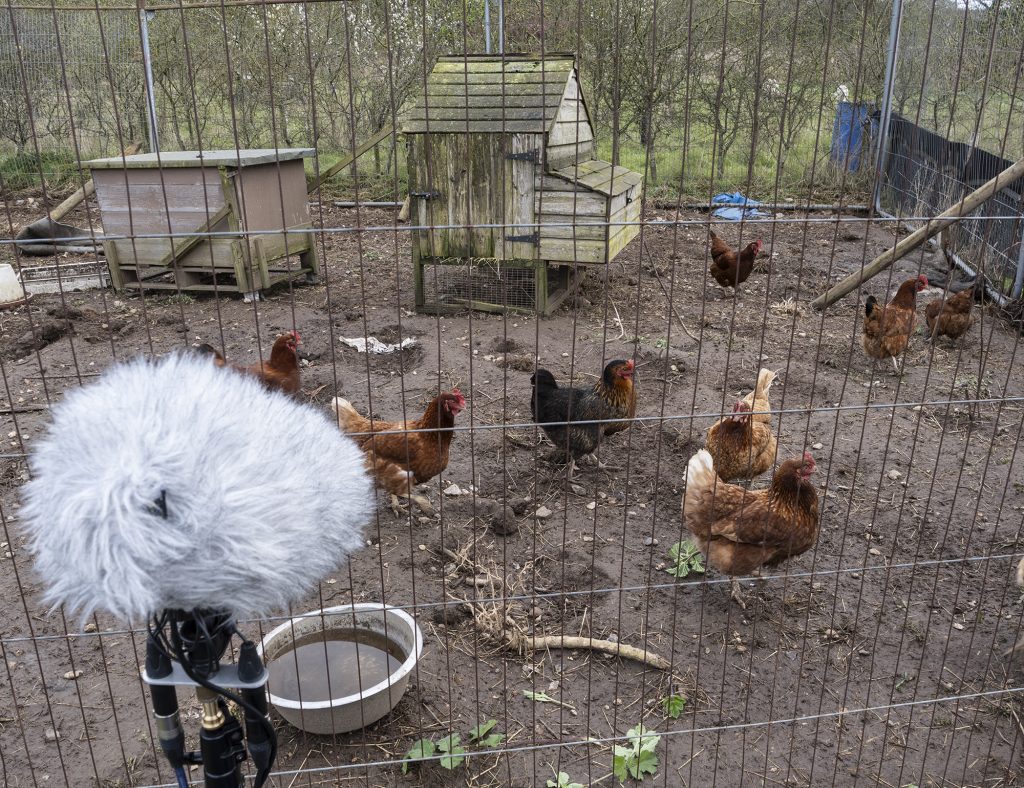
This becomes more obvious still in the following series of recordings: some fairly quiet chickens in their pen scrabbling around and clucking quietly, while a distant road (more line 200 yards/200 metres away) and some distant agricultural machinery (a drier of some sort I think) add some less wanted background noise that is least evident – naturally – the MKH 8050 mid-side pair. Not the most exciting field recording ever made, I know, but it illustrates the point!
Conclusions
The main purpose of this post – as with so many of the other tests – is to provide the reader with a few samples to draw their own conclusions. But, beyond that, what is crystal clear to me is that there is no oddity with the MKH 8050 and MKH 8030 mid-side combination: the pair perform exactly as one would expect – and hope – of a mid-side pair with a supercardioid mid mic.
As well as demonstrating the MKH 8030 as the side mic with a range of other MKH 8000 series polar patterns (arguably those that will be used most frequently in mid-side recording), I hope this post also provides some useful examples of the impact of the different mid-mics on the stereo field, which, of course, give rise to different virtual mic patterns: the omni mid-side pair is nominally equivalent to an XY pair of cardioid microphones oriented back-to-back (180 degrees); the cardioid mid-side pair is nominally equivalent to a pair of supercardioid (often incorrectly cited as hypercardioid) microphones at an included angle of about 130 degrees; the supercardioid mid-side pair is nominally equivalent to a pair of hypercardioid microphones at an included angle of about 120 degrees. I say nominally since the equivalent microphone patterns don’t exactly match definitions for existing microphones and sound directly in front of the pair is on axis to the mid mic and, therefore, suffers less colouration than with its XY equivalent. Normally one would make mid-mic choice before recording, giving a simple two-mic mid-side pair rather than something like the clunky and impractical four-mic rig that I used for these tests.
And these tests are, perhaps, a reminder to those not so familiar with the idea, that the mid mic need not be a cardioid. In particular, the sound samples show that an omni mid mic can be an effective choice, certainly if you want, or need, the bass response of an omni mic. For field recording in particular, it offers this bass response in a much more compact form than most spaced pairs (typically involving two windshields and a stereo bar).
Indeed, you can use a mid-side pair of the MKH 8000 series mics in a small blimp: below, for example, is an MKH 8040/MKH 8030 pair in the small Rycote Nanoshield NS1-BA, which is only 220mm long. Obviously it would be much better with purpose-built MS lyres, which I hope we will see before too long, to bring the mic pair into the centre more and, thus, make wind protection much more effective. And while not a full blimp, Cinela are promising a compact COSI windshield for an MKH 8030 mid-side pair, having demonstrated a prototype at IBC 2023. In short, small and light windshield options will be available to take advantage of the small size of the mid-side pairs, for those occasions when larger windshields – with their better wind protection – are not needed or wanted.
